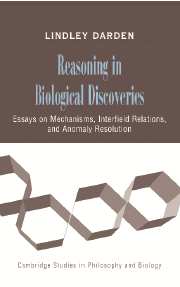 Reasoning in Biological Discoveries
Reasoning in Biological Discoveries Published online by Cambridge University Press: 31 August 2009
INTRODUCTION
Crucial pieces of the mechanism of protein synthesis were discovered by biochemists and molecular biologists in the 1950s and 1960s. At the outset, the approaches of these fields were very different, focusing on different components and finding different aspects of the mechanism from different ends. By about 1965, the results from the different approaches were integrated. The scientific work leading to this integration reveals general strategies for discovering mechanisms.
This instance of interfield integration, like many other discovery episodes in the biological sciences, crucially involves discovering a mechanism. Focusing centrally on mechanisms provides new ways of thinking about discovery, interfield integration, and reasoning strategies for scientific change. Philosophers of science have separately analyzed scientific discovery, interfield relations, mechanisms, and reasoning strategies. This chapter brings together these disparate topics. A unified approach yields reasoning strategies in discovering mechanisms that integrate results from different fields.
Many philosophers of science (e.g., Popper 1965) have been skeptical about finding methods for reasoning in discovery. Even those who have had much to say about scientific change (e.g., Kuhn 1962; Laudan 1977; Kitcher 1993) have not even discussed reasoning strategies for discovering new paradigms, traditions, or practices. Nonetheless, a few philosophers have worked on discovery (e.g., Nickles, ed. 1980a, 1980b; Meheus and Nickles, eds., 1999). Reasoning in discovery is a more tractable problem if discovery is viewed as an extended process of construction, evaluation, and revision (Darden 1991).
To save this book to your Kindle, first ensure [email protected] is added to your Approved Personal Document E-mail List under your Personal Document Settings on the Manage Your Content and Devices page of your Amazon account. Then enter the ‘name’ part of your Kindle email address below. Find out more about saving to your Kindle.
Note you can select to save to either the @free.kindle.com or @kindle.com variations. ‘@free.kindle.com’ emails are free but can only be saved to your device when it is connected to wi-fi. ‘@kindle.com’ emails can be delivered even when you are not connected to wi-fi, but note that service fees apply.
Find out more about the Kindle Personal Document Service.
To save content items to your account, please confirm that you agree to abide by our usage policies. If this is the first time you use this feature, you will be asked to authorise Cambridge Core to connect with your account. Find out more about saving content to Dropbox.
To save content items to your account, please confirm that you agree to abide by our usage policies. If this is the first time you use this feature, you will be asked to authorise Cambridge Core to connect with your account. Find out more about saving content to Google Drive.